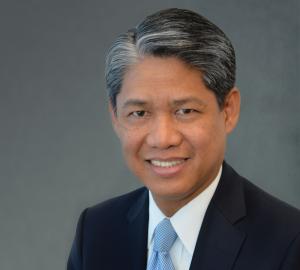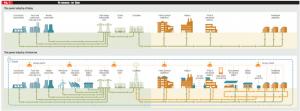In New York it’s where we’re staking our energy future.
Gil C. Quiniones is President and CEO of the New York Power Authority, the nation’s largest state-centered public power organization. Follow him on Twitter: @GQEnergy
Please forgive me for being a little conflicted about the smart grid.

Don't get me wrong. Embracing state-of-the-art technology and market innovations that produce more reliable, flexible and efficient energy is an easy sell. After all, whatever we spend on technology upgrades on the grid for the rest of this century will cost a lot less than completely rebuilding the grid.
Yet at the same time, all the promise and potential of the smart grid cannot mask the simple truth that, despite all of the digital advances and technology breakthroughs, the grid will remain the primary source of electricity for residents and businesses across the country.
Without question, the growing focus on microgrids, renewables, energy storage and the like is not only commendable, but essential. Still, the attention devoted to those innovations cannot mask the fact that, for now, they continue to be supporting players in the energy mix. Figures released by the Federal Energy Regulatory Commission in May indicate renewables account for just 17 percent of operating generating capacity, although we can take some encouragement from the fact that they account for 65 percent of new capacity. For now, though, I look forward to the day when renewables' share of transmission and distribution will be enough to make the smart grid just the plain old grid.
Since this era remains on the horizon, it will be more productive to talk about the integrated grid. I prefer this conversation because it recognizes that the power industry needs to be more inclusive to adequately address modern energy needs. The old must embrace the new so both can thrive. Central station plants already interact with solar arrays, wind farms, cogeneration and microgrids, but we need those interactions to become more frequent and seamless. (Download Figure 1 in pdf format here.)
A Daunting Objective
 Figure 1 - Rethinking the Grid
Figure 1 - Rethinking the Grid
The integrated grid is a favored topic of discussion at the Electric Power Research Institute and not just because it coined the term. Rather, it emphasizes the need for much more research and development. As chairman of EPRI, I know that R&D is essential because, while we have a well-defined sense of where we are heading, we must still answer an innumerable array of questions. We will need our scientists, engineers and labs to identify new ways to make our grid more efficient and reliable. They are collectively rethinking what we know about the underlying premises of energy and seeking answers to how to solve critical basic materials and chemical engineering problems.
As part of this progress of relentless discovery, we need to find the best ways to connect various distributed energy resources so that the grid is to be truly integrated. Much of the growth of distributed energy resources (DERs) can be attributed to the increasingly pervasive use of solar photovoltaic systems. EPRI researchers are working on the standardization of technical requirements and settings for DERs in the event of a system disturbance. They are also helping to develop default settings that are technology-neutral.
Of course, achieving these objectives will be daunting, especially when we have to take into account disparate generators, interstate interfaces and connection points. All this activity makes the task of monetizing solar and wind harder to accomplish since we must operate those intermittent power sources while keeping our existing delivery systems stable. To address these concerns, EPRI has conducted extensive invaluable research on smart inverter devices and electric feeder impacts.
The importance of that research was reinforced in an EPRI study on wind power, which concluded that "wind inherently is variable, difficult to accurately predict, and frequently anti-correlated with electricity load. The often remote location of wind resources relative to load centers requires cost-effective transmission." But at the same time, "high penetration of wind power is expected to produce power system impacts that can be reduced through smarter power plant interconnection, transmission and resource planning, and system and market operations." Such conclusions provide additional evidence of the many benefits of an integrated grid.
Similar thinking applies to the versatility of microgrids. They are sought as much as for their ability to interact and complement the traditional grid as they are to act as islands that keep the power on during extreme weather events. But we must regard microgrids as more than a hedge against 100-year storms, even when they arrive more than once a century. We need to embrace microgrids because they may be friendlier to the bottom line than a new substation will be in certain applications.
The same cannot be said about renewables, at least not yet. That will change, of course. Bloomberg New Energy Finance estimates the cost of a PV solar plant will be cut almost in half over the next 25 years. And the International Energy Agency estimates that solar could be the largest source of electricity by 2050. That alone could be enough of a value proposition to bet big on renewables. But a more compelling reason might come from our customers. They want renewables. From my vantage point that can only be a good thing. The more tactics we have to leverage these additional sources of power, the bolder our strategy can be to ensure we have a resilient and versatile energy delivery system.
Under No Illusions
Some of that thinking underpins Reforming the Energy Vision (REV). This multifaceted plan, put forth by New York Gov. Andrew Cuomo, is designed to spur clean energy innovation, while overcoming market barriers to increase new investments and improve customer choice. The end result: a safe, clean and affordable energy infrastructure that creates jobs and fuels economic development.
In a way, utilities - at least in the Northeast - face their version of a 100-year flood just about every year. So much of our generation and transmission capability is designed to handle the demand for those few days when the mercury heads north of 90 degrees for days on end. So, while we all want our HVAC systems to rise to the occasion when the dog days of summer are barking, the tab for the infrastructure to ensure that happens is steep; and regardless of the temperature, customers must foot the bill. The promise of REV is that if we can make the grid more efficient, over time we can potentially save money as well as cut greenhouse gas emissions, especially when renewables take on a more prominent role.
That is the broadest of brushes of REV, which also aims to spur innovation by breaking down market barriers to empower communities and thereby give customers more opportunities for energy savings and local power generation. The end result: an energy infrastructure that is at once safe, clean and affordable.
This is not aspirational. This is where New York is staking its energy future. As part of the governor's energy leadership team, I am under no illusions that this is anything but a complex undertaking. We're not just shifting paradigms, we're creating new ones. Admittedly, that's not something the utility industry has always been good at doing. Embracing DERs and renewables does not come naturally when we are used to generating power with a system that has generally worked fine for decades - except when it doesn't, as we found out during the 2003 blackout.
Still, the integrated grid is not about starting all over again. Our infrastructure often shows its age, but I believe, as an industry, we have an incredibly strong foundation. Now is the time for some new durable, connective tissue.
Two New Projects
I'm particularly proud of two ways forward that have been illustrated at the New York Power Authority. First, the Marcy South Series Compensation Project which will ease congestion on transmission lines without having to build new ones. Along with our partners at New York State Electric & Gas, we're installing three capacitor banks to an increase of more than 440 MW of power along existing lines, with sources that are expected to include renewable power. This will enable NYPA and NYSEG to more efficiently move power from upstate New York to the dense population centers in the New York City area.
A second project will provide NYPA with one of the most advanced transmission hubs in North America. It's being built in a switchyard at the St. Lawrence-FDR hydroelectric power project in Massena, and is where the rubber meets the digital road. The project includes microprocessors that adapt to dynamically changing conditions to communicate real-time information to switchyard components and plant operators.
This initiative will allow for precision monitoring to instantly detect any potential problems that should be anticipated or mitigated before there are any equipment failures. Though it won't be completely installed until 2023, the project is already providing NYPA with greater situational awareness of transmission conditions. This is the kind of technology that will be essential to ensure the seamless operation of an integrated grid, no matter what form it ultimately takes.
Bringing this extremely intricate technology online is yet another formidable challenge for utilities, just like our need to mitigate the effects of climate change. Every utility faces these problems, which speaks to the need for all of us to work together so the potential of the integrated grid can be realized.
It's the smart thing to do.

